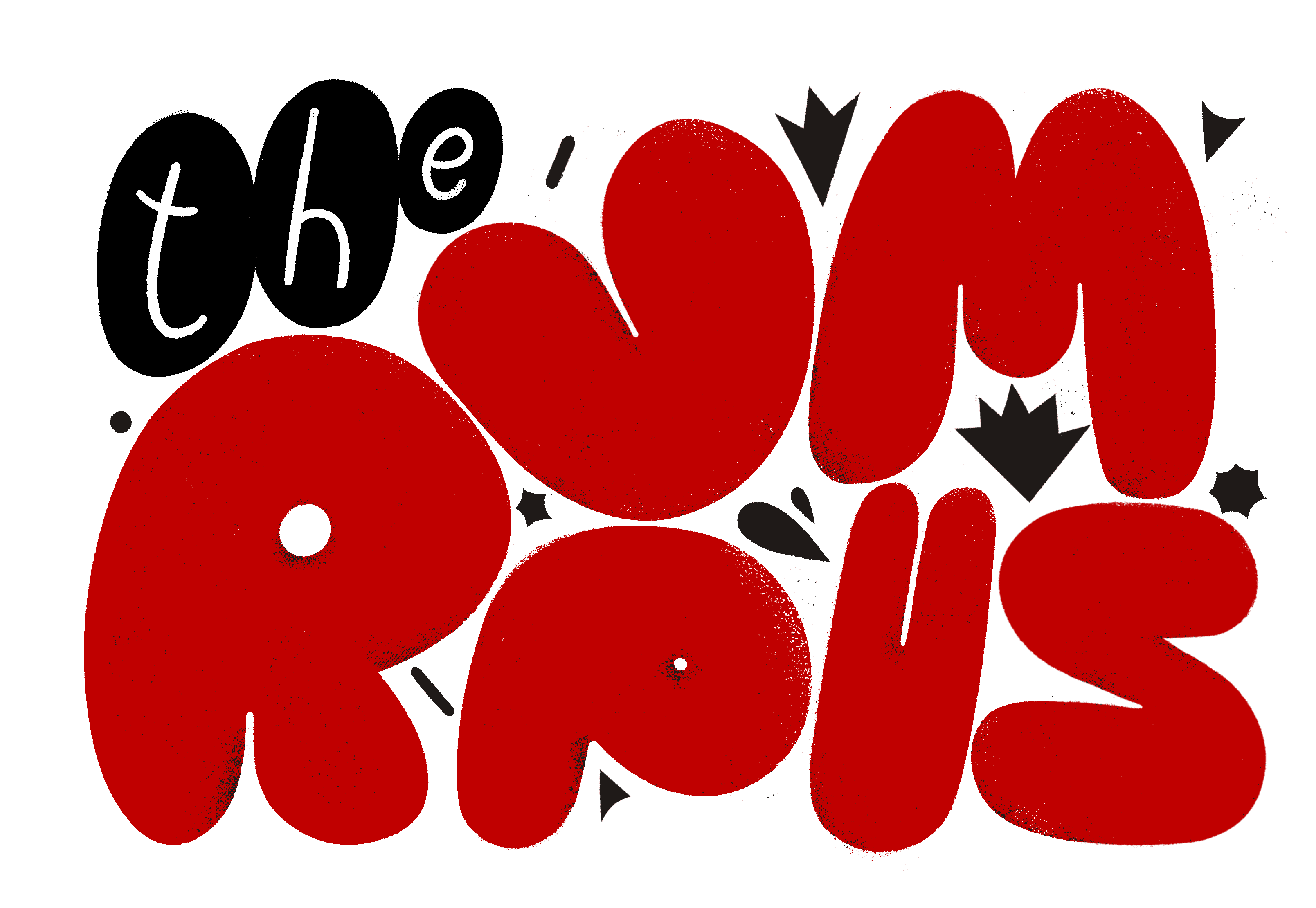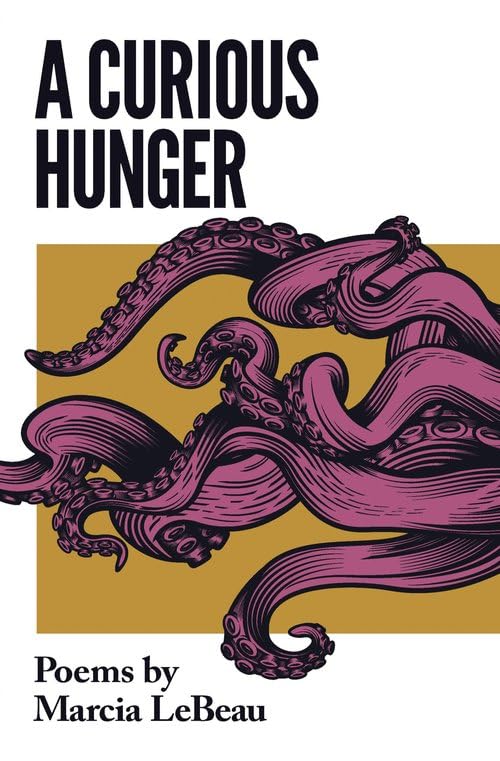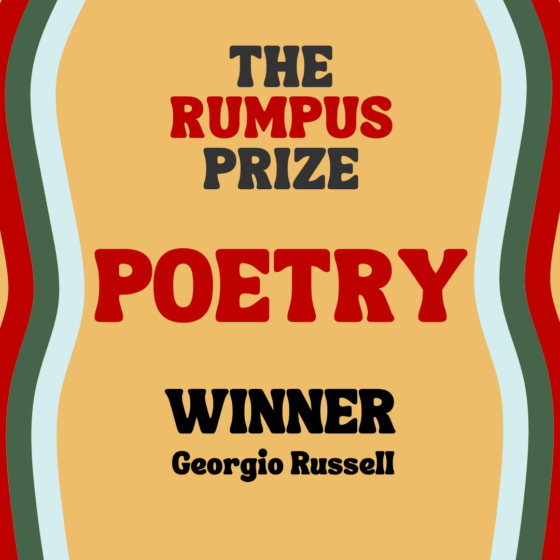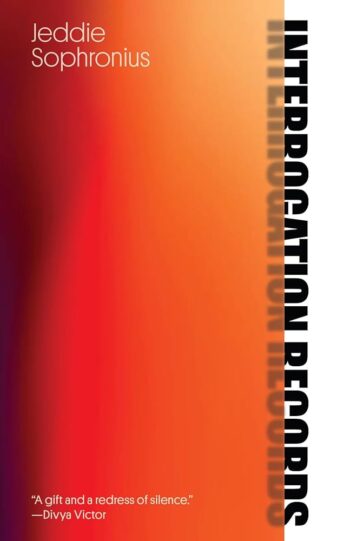
As an undergraduate, as part of a module on Tragedy, my supervisor assigned the 2012 film The Act of Killing, directed by Joshua Oppenheimer, to me and my peers. It is not a film that makes for easy viewing: occupying a liminal zone between documentary and surrealistic pastiche, Oppenheimer recruits various individuals who participated in the massacres in Indonesia between 1965 and 1966 and has them recreate their favourite, most grisly murders in their preferred film style. Film noir, for example. Not only was the film discomfiting in the brutal challenge it presented about the ethics of spectatorship and witness, but it was also the first time I learned about the massacres at all.
It is with some remorse that despite my growing up in Singapore, I had known very little about the histories of many of its Southeast Asian neighbours. My ignorance toward the mass killings that took place across Indonesia, in the same year when Singapore became independent, felt like a particularly conspicuous stain. As a graduate student, in a political anthropology class on Southeast Asia, I would read historian Geoffrey B. Robinson’s systematic and forensic study The Killing Season: A History of the Indonesian Massacres, 1965–66, which provided a comprehensive overview of the violence that erupted in the aftermath of the assassination of seven Indonesian Army generals as part of a failed coup by members of the Indonesian National Armed Forces.
These efforts were blamed on the Partai Komunis Indonesia (PKI), or the Communist Party of Indonesia, which quickly lead to the orchestration of killings at a horrific, widespread scale of anyone with even the slightest tar of communist affiliation. Robinson builds the case that these killings were indiscriminate, cutting across gender, ethnicity, religion, and geography, vividly describing scores of bodies in fields. Oppenheimer’s film sees the gangsters, to whom such state violence was outsourced, reminiscing over how they would strangle, stab, and throw people into rivers. Most egregious was the quiet endorsement and abetting of such violence by the United States, who Robinson presents as facilitating mass murder and incarceration.
As far as I am aware, Jeddie Sophronius’s Interrogation Records (Gaudy Boy, 2024) is the only Anglophone poetry collection I have encountered that seeks to make the massacres its thematic centrepiece. It is a foray into a genre where the massacres have not often featured prominently, least of all in the English-speaking world. Sophronius adopts an archivist’s eye: his personae move in and out of the archives, variously inhabiting the positions of historical figures suffering under systematic violence and a present-day reader of government records of the period. There is a spare, disaffected quality to some of Sophronius’s poems, starting with the collection’s opening poem “Origin of a Disaster.” Prefaced by a quote from a Washington Post article in 1966 describing the mass murder of peasants in a pit, the persona proceeds:
Once in a lifetime, a massacre.
Every three massacres or so,
a migration of ghosts. The deadclimb from closed pits or writhe from piles
[. . .]
of limbs.Once God forgets a country,
rivers disappear, rainforests
burn, a village girl heaves herdaily water from the well, finds
only redness. Each disaster
remains as a reminder tosujud, beg God to come back. Fast
and repent if you must, repent
now. The sin is already done,the sin of your fathers, forefathers.
Come here now, sit down, and listen:
the ghosts are here to testify.
Sophronius operates within a poetics of witness, of remembrance. The persona’s language is fraught with the knowledge of a perception of generational sin, an exodus of slaughtered souls that remain as spectres. Violence seeps, quite literally, into daily life—the “redness” in the waters of a well. Such a “disaster,” with mass killings occurring across the archipelago, can only compel a penitence. However, the poem seems to imply the absolution of a present generation. Ghosts return to bear witness to violence. One is reminded of Theresa Hak Kyung Cha’s Dictée, where speakers struggled to articulate experience of struggle and war. No such hindrance remains for the ghosts of Indonesia’s past, summoned and attended to in Sophronius’s poems.
In these poems’ critique of the cruelty of the period, Sophronius sets up for himself the herculean task of articulating a counternarrative to that which has held dominant in Indonesia over the last fifty years. This position is somewhat vexed given that Sophronius is Indonesian Chinese, part of a minor, if influential, community. What renders Sophronius’s project even more complicated is its use of English. Bahasa Indonesia remains Indonesia’s national language, while over 700 other languages—including Javanese, Balinese, and Buginese—form the country’s linguistic tapestry. English in Indonesia, while perhaps not naturalized yet, remains a lingua franca for matters of commerce and government, though this in itself continues to create a sense of linguistic distance from the victims of the massacres themselves.
Gilles Deleuze and Félix Guattari once proposed a definition of a “minor literature,” or “that which a minority constructs within a major language.” Its fundamental characteristics include that “language is affected with a high coefficient of deterritorialization,” “everything . . . is political” and “everything takes on a collective value.”[1] Sophronius’s task in Interrogation Records draws to mind these attributes. Its critique of the massacres is unabashedly political. Their use of English suggests a reading audience beyond the majority of the Indonesian reading public, particularly given its publication within the Anglophone metropole of New York through Gaudy Boy. The use of English is perhaps less entwined with postcoloniality, given that Indonesia was a Dutch colony, but is nevertheless indicative of the cultural imperialism that has accompanied the hegemony of the United States in Southeast Asia. It is a deterritorialized English of a sort, though also reflective of Sophronius’s training and employment as a poet in Michigan and Virginia.
And lastly, whether intentionally or not, Sophronius assumes some of the burden of national representation—a counternarrative of the Indonesian masses who have suffered, through his position as a poet of the massacres where there are few in the Anglophone world. Sophronius has also been vocal about the Sinophobic erasure experienced by the Indonesian Chinese; in a list of poetry collections by Chinese Indonesian poets for Electric Literature, they describe how the anti-Chinese legislation of the New Order suppressed the use of Hanzi, Chinese literature, culture, philosophies, and traditions. While they cite Edward Gunawan, Will Harris, Li-Young Lee, T. Liem, and Cynthia Dewi Oka as part of a constellation of Chinese Indonesian poets, Sophronius writes that:
The lack of Chinese Indonesian voices, especially in poetry, mirrors a long history of violence, stemming from colonialism and occupation to cultural genocide and ethnic cleansing—resulting in the suppression of our cultural heritage.
Moreover, Indonesian literature has yet to receive its deserving level of global recognition despite, as Benedict Anderson has described, being in literary terms “the most creative country in Southeast Asia,” producing writers such as Pramoedya Ananta Toer, Chairil Anwar, and Iwan Simatupang. It has done so by merging its “lingua franca and national language in an uncoercive manner,” that being Bahasa Indonesia, though he has also written that the “coercive imposition” of the language by the state has “encouraged neo-traditionalism.” The choice of many minority writers to write in English reveals the “intent of rejecting neo-traditionalism” but also “reaching an international audience.”
This creates a series of overlapping tensions within Interrogation Records. Sophronius writes from an awareness of Chinese Indonesian marginality, yet the pulse of the collection’s counternarrative coheres around an Indonesian national identity. The majority of the massacres’ victims would not have been able to speak English, yet awareness of their plight was facilitated by Anglophone reportage from American newspapers, while resurrected in Sophronius’s present-day Anglophone poetry.
It is perhaps this that occasionally creates a sense of an affective remove from the murders themselves. Sophronius often relies on epigraphs of reportage or scholarship to contextualise his poems. Sophronius is interested in diving into historical records, positioning himself as a poet-historian of sorts. Take, for example, “Killing System”:
For the most part, the killings were carried out in a systematic and ordered manner: accounts of frenzied or anarchical massacres were rare. Victims’ throats were usually cut with knives, sickles or machetes; less commonly, and apparently only when civilians were reluctant co cooperate, the condemned persons were shot by the military.
—Greg Fealy and Katherine McGregor, The Contours of Mass Violence in Indonesia, 1965-1968
One day, lives, waiting
to be disposed, then
the next, no one wasleft. They were killing
and disposing way
faster than the newbodies were coming.
Efficient. Ripe heads,
waiting to be sliced,like watermelons,
helpless, round, asking
for the knives to kissthem. Ordered manner.
Those were the orders:
to kiss or be kissed.If they hadn’t done
it, someone else would.
If they hadn’t swungtheir machetes, something
else would’ve killed them.
Very clean. It wasall systematic.
The interplay of text and paratext, of poetry and historiography and other records, is an operative dynamic through Sophronius’s collection. They help to set the intellectual and emotional context of many of the collection’s poems, even if a cool sense of indignation carries many through their attempts to reckon with atrocity. The academic tone of the epigraph by the politics scholar Fealy and historian McGregor presents a kind of emotional distance distinct from Sophronius’s “Killing System,” its enjambed tercets, indented lines, short sentences, and careful similes crystallizing a sense of the inevitability of death many faced during the massacres.
Poems such as “Numbers, Statistics, Etc.,” “Testimony / Propaganda,” and “Interrogation Room” each feature different epigraphs, including quotes from perpetrators of the violence, cables to the US Department of State, and common sayings about communists, to achieve similar effects. “The Sinner’s Mantra,” juxtaposes a quote by journalist Nathaniel Mehr, assessing that the rural poor aligned themselves with the PKI because of its interest in representing them, against a hypnotic series of variations on Marx’s slogan “From each according to their ability, / to each according to their need.” “Genjer-Genjer” activates the mythology of the song “Genjer-genjer,” an Osing language folk song first composed during the Japanese occupation in the 1930s and 1940s to describe the poverty of the peasants of Banyuwangi, who were forced to eat the genjer plant, a weed. The New Order alleged that members of organisations affiliated with the PKI danced and partook in orgies while mutilating the generals, singing “Genjer-genjer.” Sophronius’s poem uses the lyrics of the song in Bahasa Indonesia as its epigraph, while the poem describes the harvesting of genjer-genjer “from the muddy streams / the murky ponds / and mossy lakes.” The implication here is that the weed has flourished through the nutrients of the blood and remains of the dead. Across Sophronius’s poems, there is no need to embellish the violence, not least when its brutality was gratuitous and self-evident.
One of the mechanisms of dehumanization that recurs in the collection is the dismissal of supposed communists and communist sympathizers as “chickens.” In “1965, Indonesia,” a fairly didactic retelling of the events leading to the massacres, the speaker declares, “Our people were slaughtered in a time of peace. / Like helpless chickens, many accepted their fate. […] Like helpless chickens, we didn’t know the fate / of a million souls who perished in the aftermath, / killed by their own colleagues and neighbors.” The poem “To Kill a Chicken” mimics the form of a confidential missive, as if to expose the reader to a note on killing tactics circulated among military murder squads:

The activation of the metaphor of the chicken is both chilling and potent. The comparison of a communist body to that of a chicken is to remove any form of mammalian affiliation, any pretence toward affinity, the body rendered as fragile as that of a chicken. The method is presented as simple, uncomplicated. “Reports on the Land,” which sits at the center of the collection, is a tour de force in its dramatization of violence. Not once is a victim referred to as a victim; the poem’s continual reference to them as “chickens” enacts a kind of semantic satiation that causes a view of the human victim to recede. The chicken is anthropomorphised, a perverse corollary of the human that is dehumanized. As the speaker notes:
We received reports of
PKIchickens
being slaughtered in many areas.A missionary, who returned, said
she had seen 25bodieschickens in the river;another missionary said he had seen
29 chickens in the same river.The largest slaughter was,
reportedly, 15,000communistschickens.Wounded chickens released from Surabaya
had refused to return to their homes.
The poem continues over ten pages, the strikethroughs eventually disappearing altogether. The problem of “what / to feed and where to house the chickens” is resolved by “killing them / before they were captured.” Chickens in Kediri “have been decimated.” In Bali, it was their “holy duty” to “clean their own island from chickens.” A speaker laments “If we hadn’t drunk chicken blood, / we would’ve gone crazy by now/ […] It was both salty and sweet, chicken blood.” Another speaker remarks “I’m disturbed in my sleep. / Maybe because when I strangled / chickens with wire, I watched them die.”
What Sophronius illuminates in these poems is the systematic, widespread nature of these killings. A human that is no longer a human but a chicken is slaughtered as a matter of common practice. It is a butchering with purpose. It cloaks the delusion that neighbors killing one another is in the interest of an individual, communal, or national security. Sophronius displays a fascination not only with the dehumanization that facilitated violence against those alleged to be affiliated with the PKI but also the broad coalition of religious groups who opposed the whiff of communism on the basis of its alleged atheism. That the murder of one’s neighbours is regarded as a “holy duty” is revealing of the frantic, panicked conviction of piety that Sophronius identifies as beneath this outbreak of mass violence. The poem “Holy Duty” presents a duelling set of stanzas, contrasting the views that the violence was motivated by a religious belief that “Killing was a duty” and the victims were “enemies of God” and that they were the result of “propaganda” and that “They didn’t have to do it.” One of the poem’s three epigraphs comes from Ted Yates, a reporter who frames the violence as “a power struggle between communist atheism and fanatical Muslims, Hindus and Christians.” The poem “Temple Gate,” reminiscent of George Herbert’s shape poems by emulating the eponymous gates, speaks of not only of a religious obligation to kill, but a religious pleading for absolution. In the poem “Nrimo,” itself a Javanese word referring to one’s acceptance of a situation, the speaker likens the acceptance of the devastation of natural disasters like earthquakes and tsunamis to the victims’ acceptance of death. “Do not question God’s will,” the speaker says. “If their children / were murdered, do not blame God / or the killers, the bayonets and sharp wires, / the stray bullets” he states. Rather, “Say thank you. Thank you for saving our country.” And in “Island of Souls,” the poem features the repeated incantation:

A kind of religious fundamentalism becomes entwined with pro-military, pro-state forces of conservatism, a playbook that comes to be replicated by other regimes that embraced “the Jakarta Method” across Latin America and other countries subject to American intervention in the Cold War. In The Jakarta Method: Washington’s Anticommunist Crusade and the Mass Murder Program that Shaped Our World, Vincent Bevins highlights vividly the complicity of the US government in these anti-communist mass killings. This was later framed as “The Jakarta Method,” a means by which to crush and eliminate left-wing movements across Latin America and Asia and installing pro-US authoritarian regimes. Bevins highlights how Brazilian operatives referred to their programme of Communist eradication as “Operação Jacarta,” and anti-communist forces in Chile would intimidate left-wing groups with graffiti stating “Jakarta se acerca” (“Jakarta is coming”). Rather than being remembered for its leading role in the non-aligned movement and the promise of the Bandung Conference of 1955, Indonesia would emblematise US-abetted, state-sanctioned anti-communist violence. This was the pivotal shift from Sukarno to Suharto and the commencement of the New Order regime.
There are two groups of poems that share the same title that are interspersed throughout the collection: “Research Process” and “Annotations.” These poems perform a kind of auto-ethnography, where Sophronius himself is inserted into the collection’s narrative, momentarily taking the reader out of the intensity of the violence of the past. The various “Research Process” poems reveal a continuous narrative of personal exploration, with one in each of the collection’s five sections. In the first, the speaker travels to a bungalow, presented as a “library containing / a collection of oral interviews / with old survivors of the massacre,” finding that they are the first to visit since the person inside assumed responsibility of the archive. The speaker is unable to bring a cassette player to duplicate the recordings The librarian offers to photocopy books the speaker finds of Pramoedya Ananta Toer’s novels, rather than permitting him to borrow them. When finally entering the archive, the speaker finds “hundreds of transparent-cased cassettes,” “arranged by city. / Jogja, Surabaya, Medan.” The speaker looks for that labelled “Chandra,” a lost family name, which the speaker’s father removed from their birth certificate in favour of their middle name, Sophronius. A move of De-Sinicization. An incident of being left behind at immigration in Perth, after the speaker’s mother writes their surname incorrectly, follows. The final poem in the sequence is primarily italicized, words dispersed in the page, critiquing how “ideologies persist” from “The Dutch colonials.”
The second group, titled “Annotations,” is where a greater sense of an individuated persona emerges. The first concludes section II, two bookend section III, and two bookend section V. An interiority breaks through into the narrative of the collection. “Tonight, I can’t carry my country’s sins,” the persona writes. “Watch me bring the ‘I’ into the collective,” “My story / bleeds into the pages of history.” The burdens of certain forms of national representation interrupt Sophronius’s narrative. The next intimates a sense of the romantic:

It presents an ars poetica of relational sorrow, one replete with “screams,” “curses,” and “disowning.” There is the momentary acknowledgement of a time before “we mapped our nakedness,” an eroticism that recalls Li-Young Lee, however momentarily. In the next, the unnamed partner declares “If only you could see yourself through my eyes.” The parallels between depictions of cruelty and relational devastation are not yet clear. In the book’s final section, the next set of “Annotations” is anaphoric:
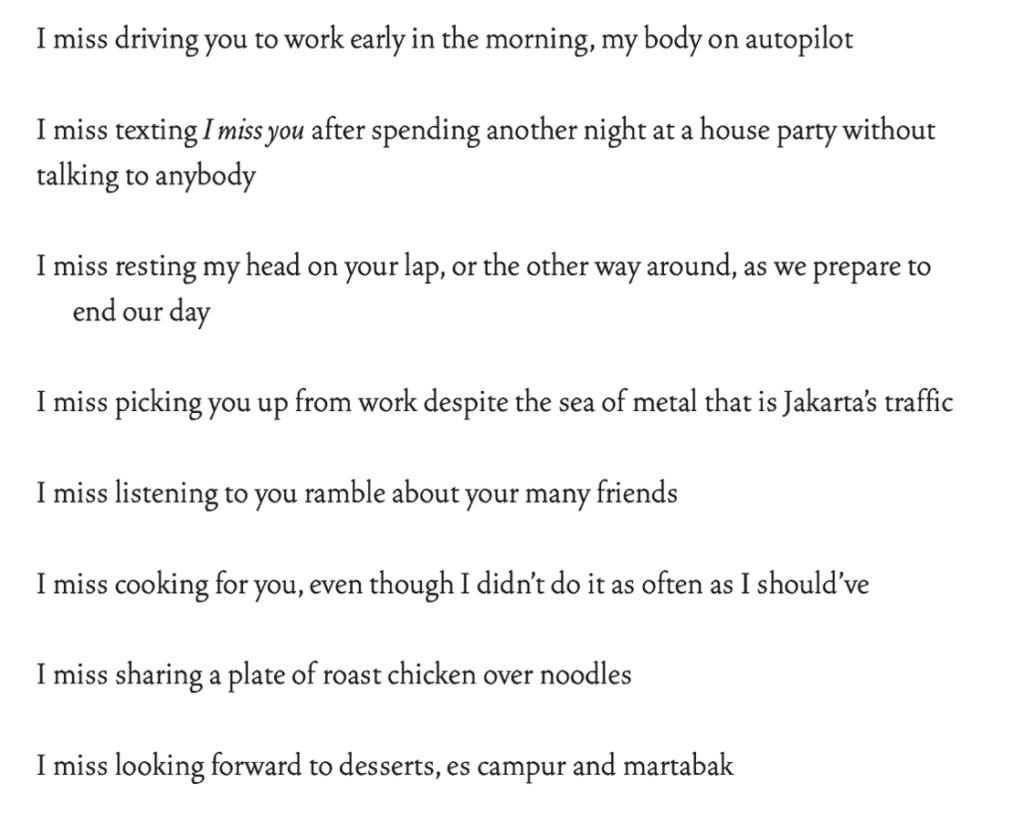
It is an ordinary, inconspicuous grief of the everyday that accompanies the speaker. Scenes of domesticity—professional, culinary, social—arise from the various settings of Jakarta. Daily intimacies, and the possibilities of living in contemporary Indonesia, provide a stark departure from the violence of the 1960s.
Yet, it is to this that the collection concludes, the speaker saying to a past lover, “This is where the last funeral ends,” an acknowledgement that their lover has “found someone else.” The collection gives its last words to Sophronius’s ex-fiancée, collapsing the distance between the speaker and the poet. Its words are lifted from a text message from them in 2019, rebutting Sophronius’s belief that marriage is impossible because of the ex-fiancée’s parents, there being an insinuation of racial and social prejudices. It implicates the reader, creating a sense of intrusion on the fracturing of an engagement, while recasting the collection in its light. Sophronius’s obsession with uncovering the truth of the massacres is seemingly linked to its ghosts in contemporary Indonesian life, down to the ways it structures social and romantic relations, even if their ex-fiancée suggests otherwise.
Presumably, the reader is not meant to bear witness to atrocity solely through the prism of Sophronius’s relational wreckage. The historical records that Sophronius interrogates are damning enough, the poems incisive, unsparing, and unrelenting in the ways they bear witness to trauma, to the piles of bodies and bloodstained lands commonplace in Indonesia in the 1960s. More than 50 years on, the fallout of these mass killings has yet to receive a full reckoning in Indonesia. Thousands of families have yet to uncover the fates of disappeared loved ones, and older victims continue to bear the memories of violence. A Truth and Reconciliation Commission was briefly established in 2004 before being annulled in 2006. President Joko Widodo’s then Coordinating Minister for Political, Legal, and Security Affairs, Mahfud MD, told journalists in 2019 that a law was being drafted to revive the commission. While he vowed to “crush” PKI if it reemerged in a statement in 2017, Jokowi did formally acknowledge the human rights violations of the 1965-1966 massacres in a televised address in 2023, promising to compensate victims and prevent such abuses from occurring again. Makbul Mubarak’s 2022 film Autobiography dramatizes the tension between a younger generation of Indonesians who seek a greater reckoning with the past and the older generation representing a militarised, paternalistic order.
The poem’s closing section is a gesture toward memorialization, an acknowledgment of the political liberalisation that occurred in Indonesia after the upending of the New Order and democratic election of Presidents. Yet, the mythos of the national threat of the PKI remains—in “September 30, 2020,” commemorating the fifty-fifth anniversary of Gestapu, or the 1965 coup, the speaker writes “collective amnesia erases / the ill chickens, deaths unremembered,” while the seven generals slain persist in public memory. “Apologia” cites a more recalcitrant Jokowi in 2015, declaring “I haven’t thought of apologizing,” to which the speaker writes:

And the poems “Stillness, Silence,” “Blood Letting,” and “Diorama of Ghosts” each provide their own approaches to coming to terms with grief. The first declares “Souls, your children forgive you / for leaving. They forgive your killers / for their deeds.” It is a healing that occurs among the descendants of the victims. The second provides a lush description of Indonesian towns and landscapes: “lush meadows,” “rice fields,” “scores of wetlands and swamps,” “temple gates, / church walls, and masjid doors,” “twisting stone valleys, their streams.” The waves wash the blood away, flowing “until it glows in the sad / horizon.” The third depicts the speaker visiting a museum commemorating the murders of the seven generals and viewing its dioramas, perpetrating the mythology that the millions of murders were justified because of these ‘revolutionary soldiers.’ It is ostensibly a state-driven narrative, one that disconnects postcolonial nationalism from communism. It is perhaps one of Sophronius’s more didactic poems, and maybe less effective than others in presenting a critique of the ways in which the massacres are remembered than others.
For those of us who continue to interact with Indonesia today, the history of the 1960s casts a long shadow over the country’s history. They inaugurated a consequential period of modern governance, from which the country has not entirely separated itself. The recent elevation of Prabowo, a former general and a son-in-law of Suharto, to Indonesia’s presidency makes clear that this entwinement with the past is both personal and political. Perhaps Sophronius represents just one of many in a more recent generation of Indonesians benefitting from a relatively greater period of openness, one willing to interrogate the country’s past and agitate for a greater national reckoning. To confront the brutality of Indonesia’s past, bound up in the Cold War politics of the 20thcentury, through literary forms and languages hitherto unexplored, may allow for the moral expiation that Sophronius seems to aspire toward. At a time of Indonesia’s own ascendancy globally, where Anglophone Indonesians like Sophronius are helping to reshape old perceptions, the urgency of such matters of truth and reconciliation may only increase, for the sake of all those to come.
***
[1] Gilles Deleuze and Félix Guattari, Kafka: Toward a Minor Literature. Translated by D. Polan (University of Minnesota Press, 1986): pp. 16-17.
